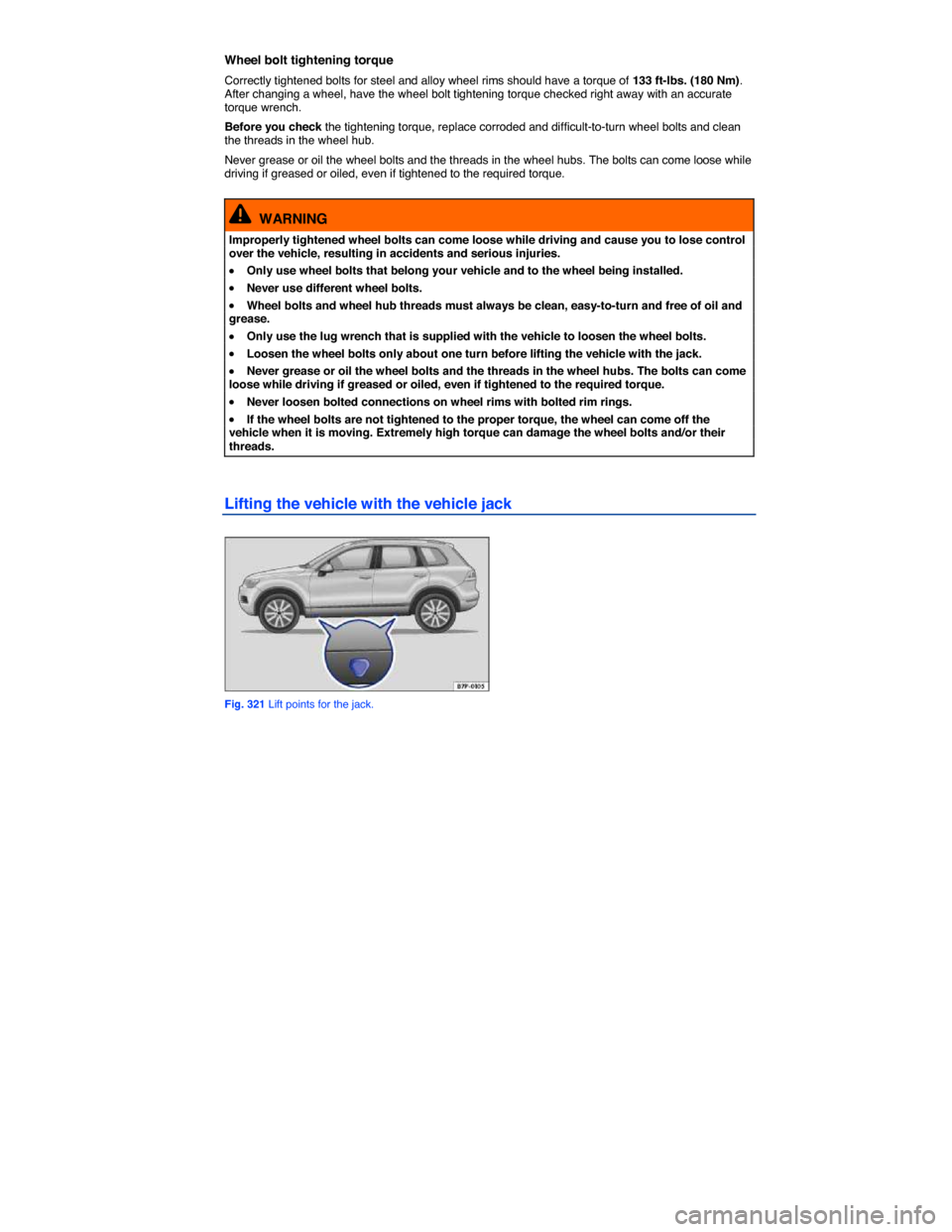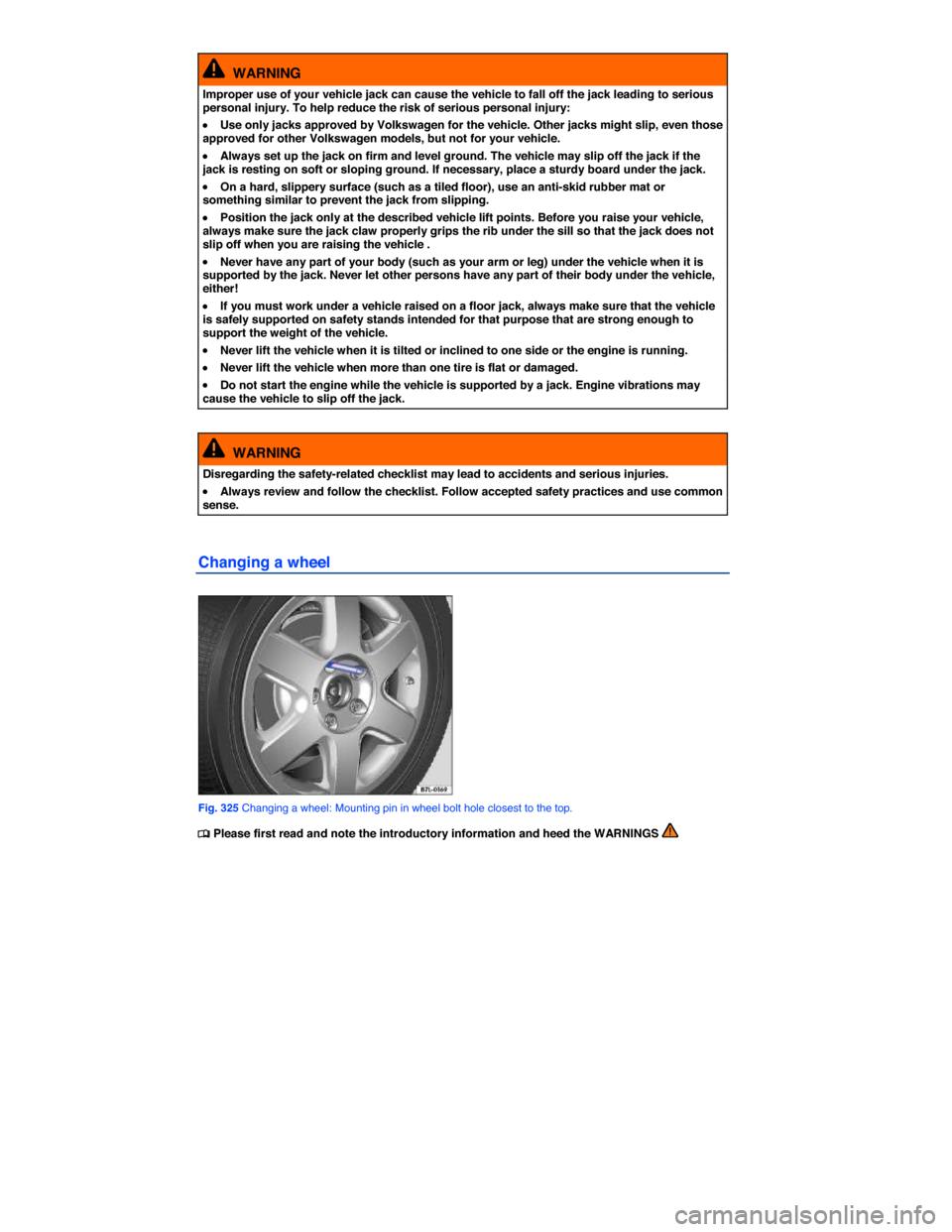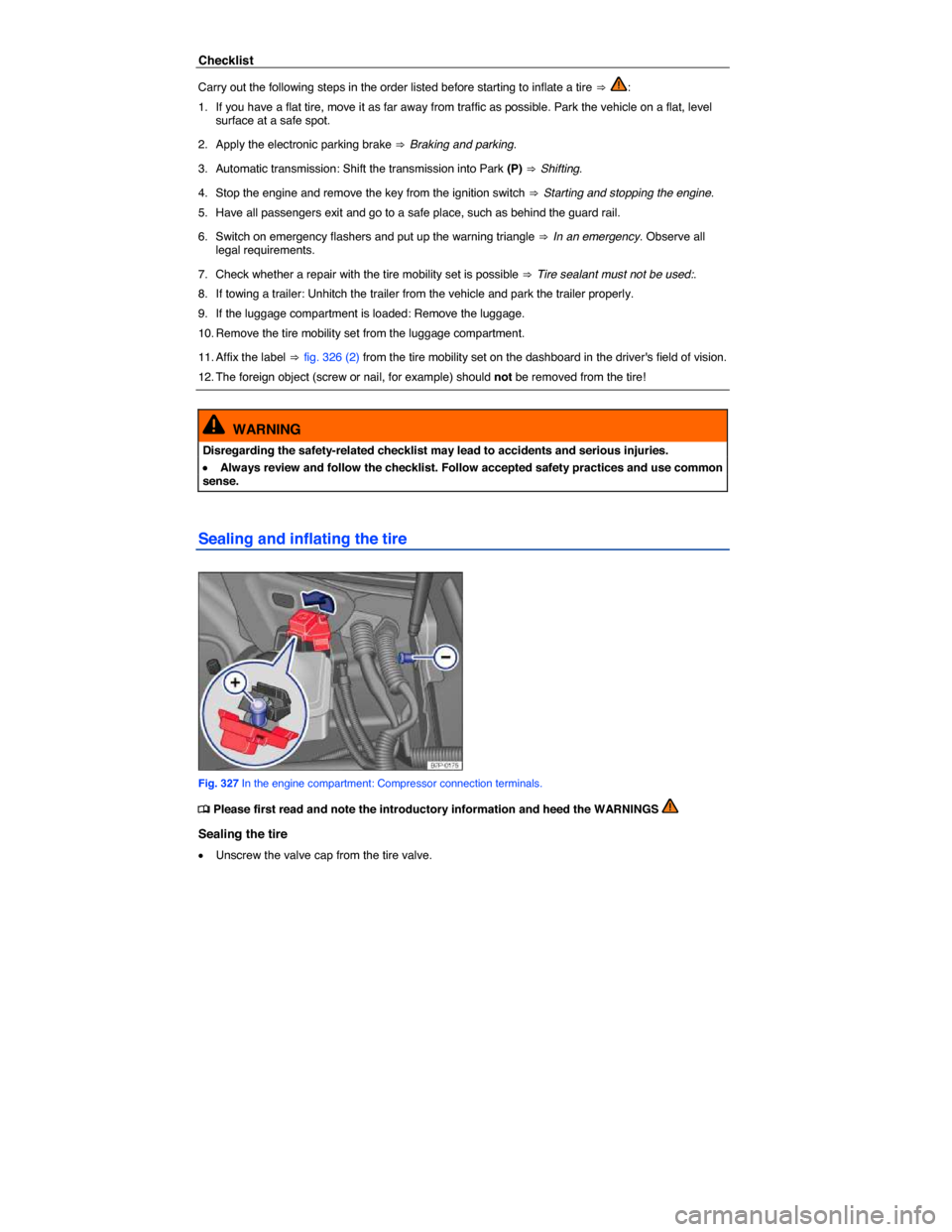2014 VOLKSWAGEN TOUAREG warning
[x] Cancel search: warningPage 547 of 620

Wheel bolt tightening torque
Correctly tightened bolts for steel and alloy wheel rims should have a torque of 133 ft-lbs. (180 Nm). After changing a wheel, have the wheel bolt tightening torque checked right away with an accurate torque wrench.
Before you check the tightening torque, replace corroded and difficult-to-turn wheel bolts and clean the threads in the wheel hub.
Never grease or oil the wheel bolts and the threads in the wheel hubs. The bolts can come loose while driving if greased or oiled, even if tightened to the required torque.
WARNING
Improperly tightened wheel bolts can come loose while driving and cause you to lose control over the vehicle, resulting in accidents and serious injuries.
�x Only use wheel bolts that belong your vehicle and to the wheel being installed.
�x Never use different wheel bolts.
�x Wheel bolts and wheel hub threads must always be clean, easy-to-turn and free of oil and grease.
�x Only use the lug wrench that is supplied with the vehicle to loosen the wheel bolts.
�x Loosen the wheel bolts only about one turn before lifting the vehicle with the jack.
�x Never grease or oil the wheel bolts and the threads in the wheel hubs. The bolts can come loose while driving if greased or oiled, even if tightened to the required torque.
�x Never loosen bolted connections on wheel rims with bolted rim rings.
�x If the wheel bolts are not tightened to the proper torque, the wheel can come off the vehicle when it is moving. Extremely high torque can damage the wheel bolts and/or their threads.
Lifting the vehicle with the vehicle jack
Fig. 321 Lift points for the jack.
Page 549 of 620

WARNING
Using the wrong jack to raise a vehicle with side steps, extended door sills, additional decorative trim or other enhancements in the area of the lower side sills can cause the vehicle to fall off the jack and result in serious personal injury.
�x Never use the standard jack supplied with unmodified vehicles to raise the vehicle. The side step can interfere with the jack when raising the vehicle.
�x Always use the scissor vehicle jack supplied with the authorized side step package when the vehicle must be jacked up, for example, to change a tire.
WARNING
Improper use of your vehicle jack can cause the vehicle to fall off the jack leading to serious personal injury. To help reduce the risk of serious personal injury:
�x Use only jacks approved by Volkswagen for the vehicle. Other jacks might slip, even those approved for other Volkswagen models, but not for your vehicle.
�x Always set up the jack on firm and level ground. The vehicle may slip off the jack if the jack is resting on soft or sloping ground. If necessary, place a sturdy board under the jack.
�x On a hard, slippery surface (such as a tiled floor), use an anti-skid rubber mat or something similar to prevent the jack from slipping.
�x Position the jack only at the described vehicle lift points. Before you raise your vehicle, always make sure the jack claw properly grips the rib under the sill so that the jack does not slip off when you are raising the vehicle .
�x Never have any part of your body (such as your arm or leg) under the vehicle when it is supported by the jack. Never let other persons have any part of their body under the vehicle, either!
�x If you must work under a vehicle raised on a floor jack, always make sure that the vehicle is safely supported on safety stands intended for that purpose that are strong enough to support the weight of the vehicle.
�x Never lift the vehicle when it is tilted or inclined to one side or the engine is running.
�x Never lift the vehicle when more than one tire is flat or damaged.
�x Do not start the engine while the vehicle is supported by a jack. Engine vibrations may cause the vehicle to slip off the jack.
WARNING
Disregarding the safety-related checklist may lead to accidents and serious injuries.
�x Always review and follow the checklist. Follow accepted safety practices and use common sense.
Page 551 of 620

2. Switch off the engine, shift the transmission into Park (P) ⇒ Shifting. Then apply the parking brake
to help prevent the vehicle from moving ⇒ Braking and parking.
3. If towing a trailer: Unhitch the trailer from the vehicle and park the trailer properly.
4. Straighten the steering wheel so that the front wheels point straight forward.
5. Block the diagonally opposite wheel with chocks or other suitable things.
6. Loosen the wheel bolts of the wheel to be changed ⇒ Wheel bolts.
7. Remove the scissors jack and tools from the vehicle.
8. Inset the extension ⇒ fig. 323 (A) into the scissors jack (B) Attach the crank (C) to the extension (A).
9. Find the jack lift point on the vehicle frame that is closest to the wheel to be changed.
10. Crank up the jack so that it still just fits underneath the lift point.
11. Position the jack so that its base is directly underneath the lift point ⇒ fig. 324, making sure that the entire base of the jack rests securely on the ground.
12. Align the jack and wind up the jack claw at the same time, until the claw cradles the rib underneath the vehicle A or B.
13. Continue cranking up the jack until the wheel is just a little off the ground.
WARNING
Using the wrong jack to raise a vehicle with side steps, extended door sills, additional decorative trim or other enhancements in the area of the lower side sills can cause the vehicle to fall off the jack and result in serious personal injury.
�x Never use the standard jack supplied with unmodified vehicles to raise the vehicle. The side step can interfere with the jack when raising the vehicle.
�x Always use the scissor vehicle jack supplied with the authorized side step package when the vehicle must be jacked up, for example, to change a tire.
Page 552 of 620

WARNING
Improper use of your vehicle jack can cause the vehicle to fall off the jack leading to serious personal injury. To help reduce the risk of serious personal injury:
�x Use only jacks approved by Volkswagen for the vehicle. Other jacks might slip, even those approved for other Volkswagen models, but not for your vehicle.
�x Always set up the jack on firm and level ground. The vehicle may slip off the jack if the jack is resting on soft or sloping ground. If necessary, place a sturdy board under the jack.
�x On a hard, slippery surface (such as a tiled floor), use an anti-skid rubber mat or something similar to prevent the jack from slipping.
�x Position the jack only at the described vehicle lift points. Before you raise your vehicle, always make sure the jack claw properly grips the rib under the sill so that the jack does not slip off when you are raising the vehicle .
�x Never have any part of your body (such as your arm or leg) under the vehicle when it is supported by the jack. Never let other persons have any part of their body under the vehicle, either!
�x If you must work under a vehicle raised on a floor jack, always make sure that the vehicle is safely supported on safety stands intended for that purpose that are strong enough to support the weight of the vehicle.
�x Never lift the vehicle when it is tilted or inclined to one side or the engine is running.
�x Never lift the vehicle when more than one tire is flat or damaged.
�x Do not start the engine while the vehicle is supported by a jack. Engine vibrations may cause the vehicle to slip off the jack.
WARNING
Disregarding the safety-related checklist may lead to accidents and serious injuries.
�x Always review and follow the checklist. Follow accepted safety practices and use common sense.
Changing a wheel
Fig. 325 Changing a wheel: Mounting pin in wheel bolt hole closest to the top.
�
Page 553 of 620

Removing the wheel
�x Review the checklist ⇒ Preparations for changing a wheel.
�x Loosen the wheel bolts ⇒ Wheel bolts.
�x Lift the vehicle ⇒ Lifting the vehicle with the vehicle jack.
�x Unscrew the topmost loosened wheel bolt using the hexagonal socket in the screwdriver handle
⇒ fig. 317 place it on a clean surface.
�x Screw the mounting pin in the vehicle tool kit into the empty hole by hand ⇒ fig. 325.
�x Remove the remaining wheel bolts using the hexagonal socket in the screwdriver handle
⇒ fig. 317 and place them on a clean surface.
�x Remove the wheel.
Mounting spare tire or collapsible spare tire
If the tire is a unidirectional tire, be sure to install it in the proper rolling direction ⇒ Unidirectional tires.
�x Put the spare tire or collapsible spare tire into place on the vehicle.
�x Screw in all wheel bolts clockwise and tighten them slightly using the hexagonal socket in the screwdriver handle.
�x Unscrew the mounting pin and screw in the last wheel bolt.
�x Lower the vehicle with the jack.
�x Use the lug wrench to firmly tighten all wheel bolts (turn clockwise) ⇒ . Do not tighten them in sequence! Tighten any wheel bolt to begin, then tighten the wheel bolt diagonally opposite the first bolt, and so forth.
�x Install the wheel bolt caps, center wheel hubcap, or wheel cover, if any ⇒ Wheel trim.
WARNING
Wheel bolts that are tightened or installed improperly can come loose, causing loss of vehicle control, a crash, and serious personal injury.
�x Always keep wheel bolts and threads in the wheel hub clean and free of oil and grease. The wheel bolts must turn easily and must be tightened with the right torque.
�x Use the hexagonal socket in the screwdriver handle only to turn the wheel bolts when they are loose, never to loosen them or tighten them firmly.
WARNING
Improper use of a collapsible spare tire can cause loss of vehicle control, a crash or other accident, and serious personal injury.
�x Never use a collapsible spare tire if it is damaged or worn down to the wear indicators.
�x Never drive faster than 50 mph (80 km/h) with a collapsible spare tire. Avoid full-throttle acceleration, heavy braking, and fast cornering!
�x Never drive more than 125 miles (200 km) with a 16" collapsible spare wheel that is installed on the front axle (drive axle).
�x Replace the collapsible spare with a normal wheel and tire as soon as possible. Collapsible spare tires are designed for brief use only.
Page 556 of 620

WARNING
Using the tire mobility set on the side of the road can be dangerous. To help reduce the risk of serious personal injury:
�x Always stop the vehicle as soon as it is safe to do so and move the vehicle a safe distance off the road where it is safe to use the tire mobility set.
�x Make sure that the ground is level and firm.
�x All passengers and especially children must stay a safe distance away from you while you are working and keep out of the area you are working in.
�x Turn on the emergency flasher and set up another warning device about 25 yards (25 meters) behind the vehicle to warn approaching traffic.
�x Use the tire mobility set only if you are familiar with the necessary steps. Otherwise, get expert assistance.
�x Use the tire mobility set only in emergencies and only until you can get professional help.
�x Immediately replace a tire repaired with the tire mobility set.
�x Sealant is harmful and must immediately be removed in case of skin contact.
�x Always store the tire mobility set out of reach of children.
�x Never use a vehicle jack, even if the jack is approved for use with your vehicle.
�x Always switch off the engine, engage the electronic parking brake, and shift the transmission into Park (P) to reduce the risk that the vehicle will move unexpectedly.
WARNING
Improper use of the tire mobility set can cause a temporary tire to fail and lead to loss of vehicle control and serious personal injuries.
�x Always remember that a tire filled with sealant does not handle as well as an undamaged tire without sealant.
�x Never drive faster than 50 mph (80 km/h) with a sealed tire.
�x Never use the tire mobility set if the outside temperature is below –4 °F (–20 °C).
�x Never drive with a tire that has cuts or punctures, especially when they are larger than 3/16 in (4 mm).
�x Use the tire mobility set only for emergencies until you can get professional help.
�x If the tire cannot be inflated to at least 36 psi (2.5 bar), do not drive the vehicle. Contact the nearest authorized Volkswagen dealer, authorized Volkswagen Service Facility, or other qualified workshop.
�x If the tire inflation pressure drops below 26 psi (1.8 bar) after driving for 10 minutes, do not drive the vehicle any farther. Contact the nearest authorized Volkswagen dealer, authorized Volkswagen Service Facility, or other qualified workshop.
�x Always replace a tire repaired with the tire mobility set immediately. Do not drive a tire that has been repaired with the tire mobility set longer or farther than is absolutely necessary.
�x Avoid full throttle acceleration, hard, braking, and fast cornering.
�x Drive at slow speed for 10 minutes. Then get out and check the air pressure and condition of the sealed tire.
Obey all legal requirements when disposing of used or expired sealant.
New tire inflation cylinders are available from authorized Volkswagen dealers and authorized Volkswagen Service Facilities.
Page 558 of 620

Checklist
Carry out the following steps in the order listed before starting to inflate a tire ⇒ :
1. If you have a flat tire, move it as far away from traffic as possible. Park the vehicle on a flat, level surface at a safe spot.
2. Apply the electronic parking brake ⇒ Braking and parking.
3. Automatic transmission: Shift the transmission into Park (P) ⇒ Shifting.
4. Stop the engine and remove the key from the ignition switch ⇒ Starting and stopping the engine.
5. Have all passengers exit and go to a safe place, such as behind the guard rail.
6. Switch on emergency flashers and put up the warning triangle ⇒ In an emergency. Observe all legal requirements.
7. Check whether a repair with the tire mobility set is possible ⇒ Tire sealant must not be used:.
8. If towing a trailer: Unhitch the trailer from the vehicle and park the trailer properly.
9. If the luggage compartment is loaded: Remove the luggage.
10. Remove the tire mobility set from the luggage compartment.
11. Affix the label ⇒ fig. 326 (2) from the tire mobility set on the dashboard in the driver's field of vision.
12. The foreign object (screw or nail, for example) should not be removed from the tire!
WARNING
Disregarding the safety-related checklist may lead to accidents and serious injuries.
�x Always review and follow the checklist. Follow accepted safety practices and use common sense.
Sealing and inflating the tire
Fig. 327 In the engine compartment: Compressor connection terminals.
�
Page 559 of 620

�x Unscrew the valve core from the tire valve using the valve core wrench ⇒ fig. 326 (1) and place it on a clean surface.
�x Vigorously shake the tire inflation cylinder ⇒ fig. 326 (10) a few times back and forth.
�x Tightly screw the filling hose ⇒ fig. 326 (3) to the tire inflation bottle (turn clockwise). The foil on the seal is automatically pierced.
�x Remove the sealing plug from the filling hose ⇒ fig. 326 (3) and slide the open end onto the tire valve.
�x Hold the cylinder with the bottom pointing up and fill the entire contents of the tire inflation cylinder into the tire.
�x Detach the empty tire inflation cylinder from the valve.
�x Using the valve core wrench ⇒ fig. 326 (1) screw the valve core back into the tire valve.
Inflating the tire
�x Screw the tire inflation hose ⇒ fig. 326 (5) of the air compressor tightly to the tire valve.
�x Check whether the air release valve ⇒ fig. 326 (7) is screwed on tightly.
�x Open the engine hood ⇒ Working in the engine compartment.
�x Attach the cable clips ⇒ fig. 326 (9) only to the jump-start terminals in the engine compartment
⇒ fig. 327. The red clip on the compressor cable is connected to the positive (+) terminal; the black clip is connected to the negative terminal (—).
�x Start the vehicle engine and let it run.
�x Switch the air compressor on using the ON / OFF switch ⇒ fig. 326 (8),
�x Let the air compressor run until a pressure of 36 – 44 psi (250 - 300 kPa) is reached ⇒ .
Maximum run time 8 minutes ⇒ .
�x Switch off the air compressor.
�x If an air pressure of 36 – 44 psi (250 - 300 kPa) cannot be reached, unscrew the tire inflation hose from the tire valve.
�x Drive about 30 feet (10 meters) backwards or forwards so that the sealant can be distributed inside the tire.
�x Connect the tire inflation hose of the air compressor again to the tire valve and repeat the inflation process.
�x If the required tire pressure still cannot be reached, the tire is too badly damaged. The tire cannot
be sealed using the tire mobility set. Do not drive the vehicle. Get professional assistance ⇒ .
�x Disconnect the air compressor and unscrew the tire inflation hose from the tire valve.
�x If a tire pressure of 36 – 44 psi (250 – 300 kPa) is reached, continue driving right away and drive at a speed of not more than 50 mph (80 km/h).
�x Check tire pressure after 10 minutes of driving ⇒ Check after 10 minutes of driving.
WARNING
The tire inflation hose and air compressor can get hot during inflation.
�x Protect hands and skin from hot parts.
�x Do not place the hot tire inflation hose or hot air compressor on flammable material.
�x Let the equipment cool off almost completely before stowing it.
�x If the tire cannot be inflated to at least 36 psi (250 kPa), the damage is too great to be repaired with the tire mobility set. The sealant is not able to seal the tire. Do not drive the vehicle. Get professional assistance.